Erenhot to Hohhot to Hostel: an exercise in frustration
Once I made my way from the random location where the jeep from the border dropped me off in Erenhot, I made my way to the railway station to get a ticket on the train to Hohhot. Unfortunately, it turned out that the train to Hohhot wasn't running that day, so I would have to make alternate plans. I went outside, and there was a bus parked out front, but it turned out that it was only running to Beijing. One of the Mongolian kids getting on the bus was interested in me, since I was a foreigner, and his mom spoke a little English. She talked to the driver, and when they heard I wanted to go to Hohhot, they told me to wait and that there would be a bus. They gave me a ride to the bus station and told me where I could get a ticket to Hohhot. Since Lonely Planet had no useful information on Erenhot, I would have been in a real jam without their help—a GPS with offline maps would also have been a lifesaver on so many occassions.
Anyway, the bus to Hohhot was interesting. All the passengers were Chinese, and they displayed typical Chinese manners: eating sunflower seeds and spitting the shells on the ground, which is also where they put their garbage; smoking even though it's a non-smoking bus; and generally being noisy and annoying. A couple of times we passed really touristy ger camps—complete with concrete gers or lots of modern buildings or restaurants surrounded by a few traditional gers (which the Chinese call Mongolian steamed buns)—and whenever we passed them the Chinese would whip out their cameras and furiously take pictures of them... on a trip in Inner Mongolia from the Mongolian border to Hohhot. I think this tells you something about just how Mongolian Inner Mongolia is—even if they do technically still use the traditional Mongolian script there.
I arrived in Hohhot an hour or so before sunset, and immediately went next door to the train station to try and buy an overnight ticket to Pingyao for departure the next evening. I was lucky enough to get a hard sleeper berth, in what was one of my easier ticket-buying experiences. This station also had turnstiles at the exit lanes to prevent queue jumping, which was a nice touch.
The next objective was to find the hostel recommended in Lonely Planet, the Anda Guesthouse. It turns out that they not only had the Anda placed incorrectly on the map, but Michael Kohn had completely botched the written directions on how to get there, with incorrect streets, incorrect bus stops, and instructions to go one direction when you were supposed to go the opposite direction. It took almost 90 minutes to find the hostel from the time I was two blacks away. When I finally arrived and checked in, other travelers told me similar stories of futility.
There was a 60-something Australian lady staying in my room that night, and we swapped storied and recommendations as she was coming from Central Asia and headed towards Mongolia—the opposite path as me. I think I got the better end of the deal, as she wrote down some recommendations in my Lonely Planet on the best places to stay and get information, whereas I only told her how to get to UB by local train.
The 2012 Olympics were on at that point, and the girls working at the hostel were eagerly watching. Chinese Olympic coverage seems to be like American: very patriotic and covering mainly the events that they do well. So they were naturally showing women's weightlifting, and I got to hear commentary from the Chinese girls about how mannish the lifters from other countries looked. Not that the Chinese lifters looked particularly feminine, but whatever.
One day in Hohhot
Inner Mongolia, like Tibet and Xinjiang, is an Aurtonomous Region. This is meant to reflect their distinct cultures and suggest additional autonomy, but in practice I think it's all window dressing. Inner Mongolia should be an example to both Tibet and Xinjiang as to just how successful Beijing can be in replacing minority communities and population with Han immigrants, though: Hohhot is almost 90% Han, with only about 9% being Mongol and 2% being Hui Mulsim; Inner Mongolia as a whole is 79% Han and only 17% Mongol.
In Hohhot you'll see Mongolian script on a lot of buildings, and the typically blocky style of quotidean Chinese architecture is enlivened with ger-like decorations on the tops of many buildings, but the feeling on the streets is decidedly Han, with the most exotic and noticeable accents coming from the Hui minority, and not the Mongols. I wonder if part of this isn't because China is a food-centric culture, and Hui food is better than Mongolian food. Of course, the fact that Hui are just Muslim Han while Mongols are not Han may have something to do with it, too.
 |
| There's a world of difference between Mongolian parks and this park in Hohhot. For one, Hohhot hardly looks anything like Ulaanbaatar (both are classified as cold semi-arid climates), as there are artificial ponds, green grasses, and lush trees. But the bigger difference is in terms of how people use the parks: in China they're real places of communal socialization and heavily used as such (here by the ubiquitous ballroom dancers). |
 |
| Rollerblading class. |
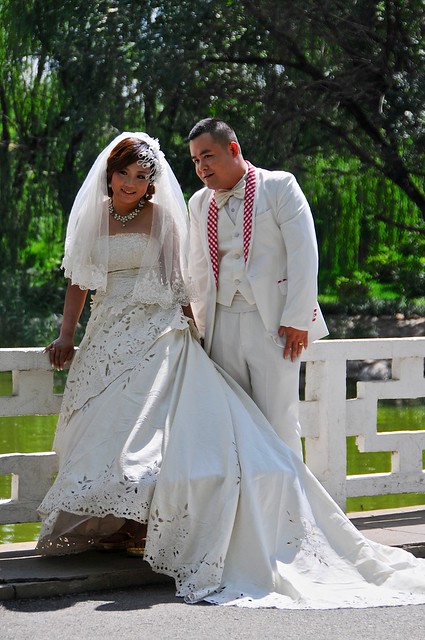 |
| Mongol newlyweds in front of ornamental pond. |
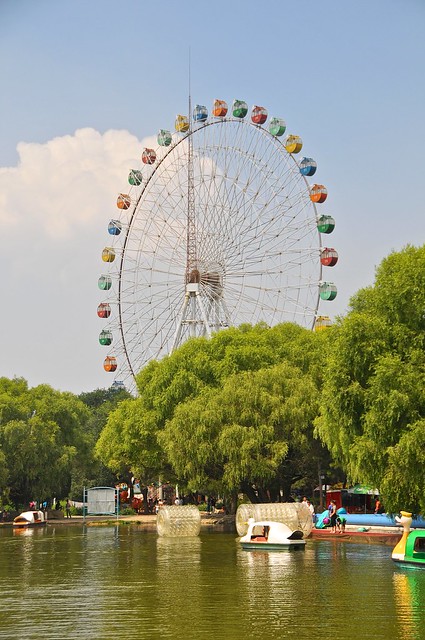 |
| Giant Ferris Wheel over another artificial lake. |
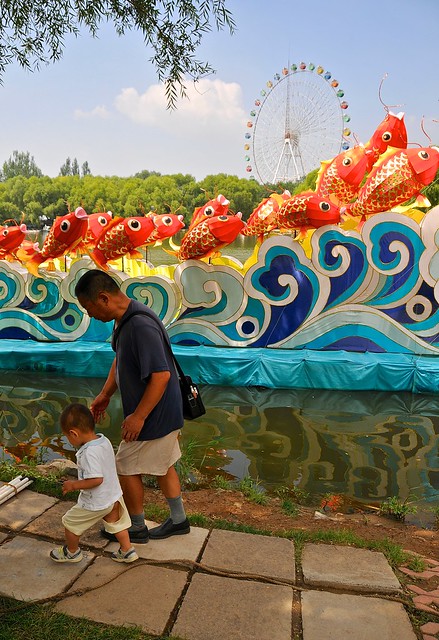 |
| Father and son at the park. Like most Chinese kids of his age, he's wearing shorts with an open rear seam, so he can squat and piss or shit whenever he wants—that's why you can see his upper thigh on his right leg. |
From the amusement park area I tried to walk to the temple you'll see below. But because the Lonely Planet maps for Hohhot are terrible (showing roads that don't exist, and roads that are at incorrect angles), it looked like the temples were not where they were supposed to be , and had possibly been destroyed or renamed. So I instead ended up going in the direction of the mosque, before realizing the problem with the maps and doubling back south.
 |
| New mosque in front of the old mosque, which has traditional Chinese architecture. There was some sort of market and auction in the tents in front of the new mosque. |
 |
| Huge jade sculpture of a bull. |
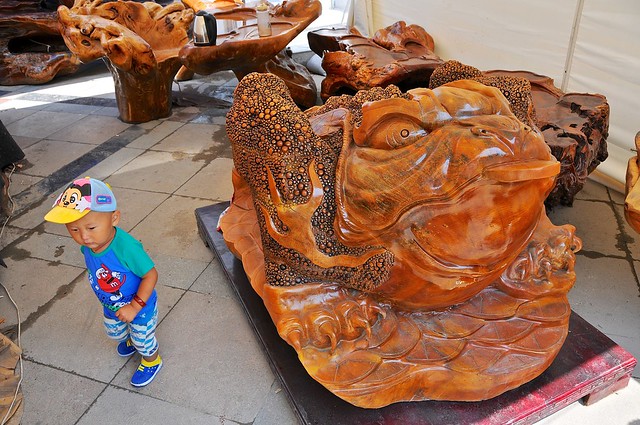 |
| Burl-wood frog-like creature. Child included for scale. |
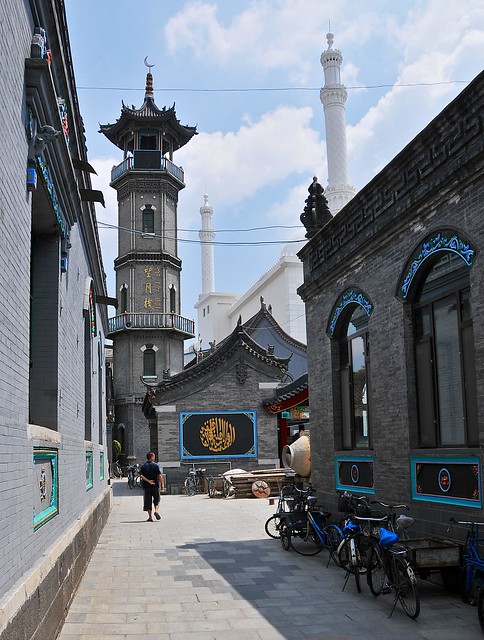 |
| The old mosque's minaret is much cooler than the new minarets that tower behind it. |
 |
| Prayer hall. Hui Muslims look Chinese, but have beards and skullcaps, and typically wear white. |
 |
| Prayer hall. I'm used to prayer halls and mihrabs facing east, so to see them facing west instinctively seems a bit weird. |
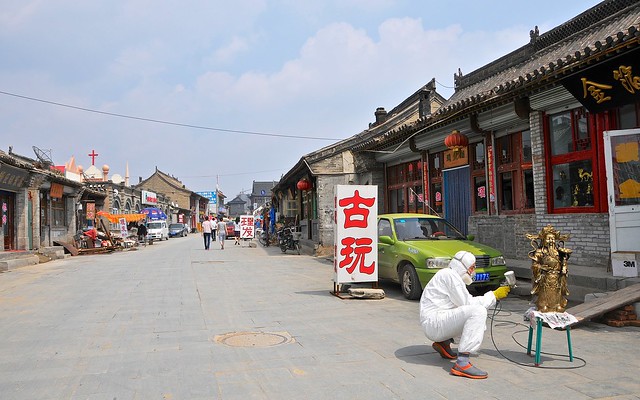 |
| South of the mosque is a traditional neighbourhood and a newly-restored temple. Here, a worker artificially ages a statue and sprays on patina. The results are quite convincing, and the only thing that really surprises me is his protective gear. Note the Christian cross over the buildings on the left. |
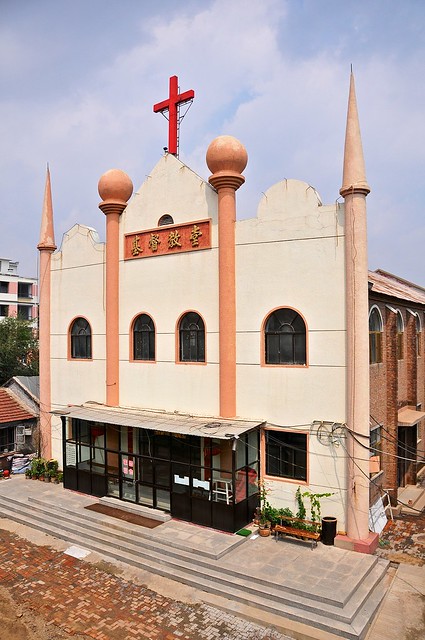 |
| There's an even bigger Catholic church in Hohhot. |
 |
| A just-restored temple. These temples have no more religious significance for the Chinese than they do for Western tourists, and quite possibly less. |
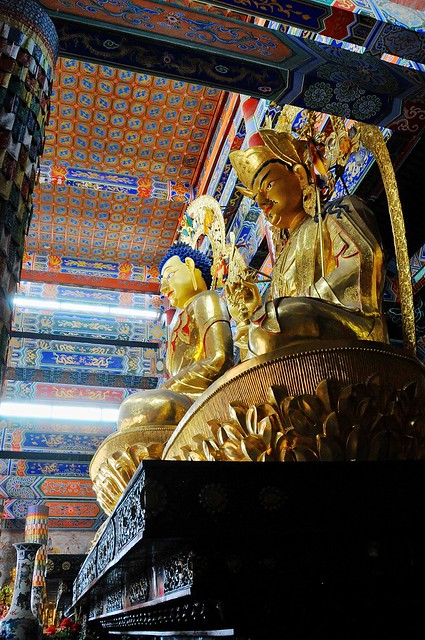 |
| Huge Buddhas inside the main building. |
After the temple, I decided to see the Inner Mongolia Museum, which was supposed to be quite good. Lonely Planet tell you to take a bus on a certain street, but neglects to tell you what direction to take the bus. It also neglects to tell you that although the street runs across Hohhot, the bus only runs on a short stretch of the street. After futilely trying to figure out how to catch the bus, I had to return to the hostel and get my bearings on how to get to the museum.
Once there, it was a pretty interesting museum. Chinese museums tend to be impressive, and it's always very interesting to read their propaganda on racial harmony and how the people of China have been unified for thousands of years and China's borders have been as all-encompassing as they currently are for a similar amount of time.
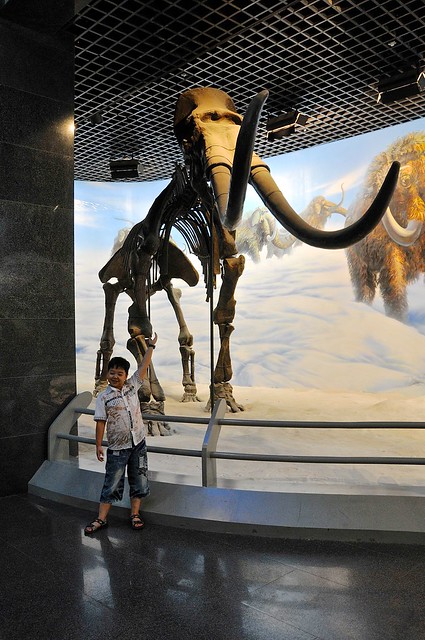 |
| Chinese kid posing like a rock-star (or Vanna White) in front of a Wooly Mammoth. |
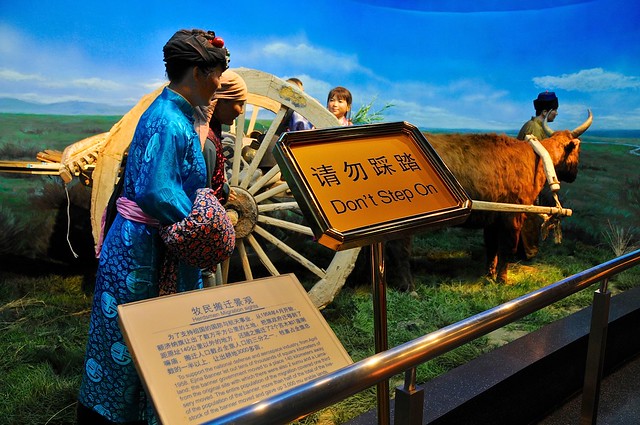 |
| I guess they have problems with people wanting to pose with the mannequins. The smaller text lets us know that one third of the population of some district volunteered to move in 1958 out of patriotic fervor in the name of national security. |
 |
| A wheeled ger and war machinery. While the National Museum in UB was interesting and informative, they certainly didn't have exhibits like this. |
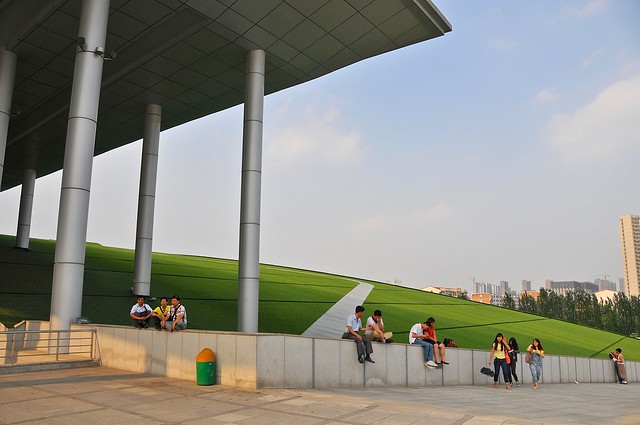 |
| The rooftop of the museum as covered with grass, and has a path, but you can't walk on either. |
I made my way to the new Hohhot East Train Station later that evening, slightly inconvenienced by the fact that the bus wouldn't go all the way because the station's access roads weren't complete, which meant I had to scramble to get there on time. As at many train stations in China, I had to go through security and have my bags scanned, and the station was almost like an airport terminal once you had passed security.



















No comments:
Post a Comment